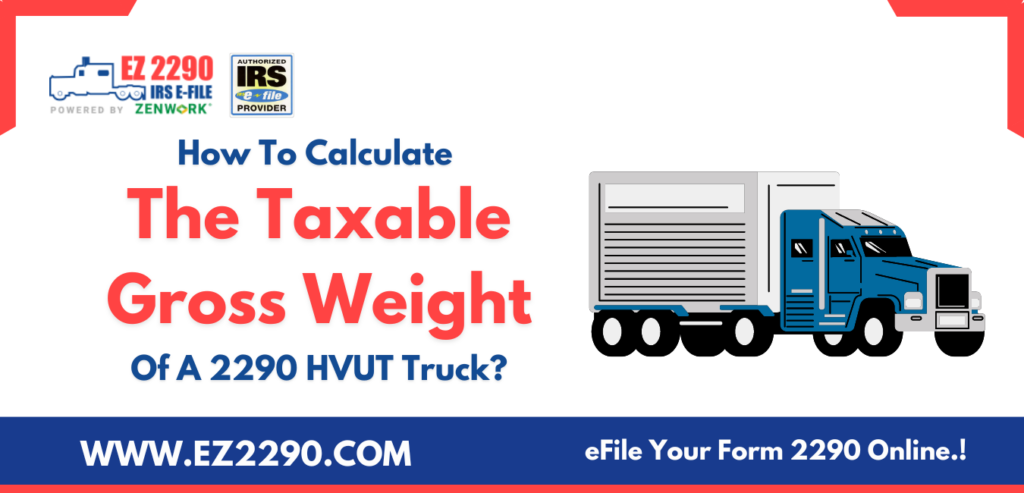
What is the taxable gross weight of a 2290 highway truck, and how do you calculate it?
Ever wondered how much a heavy highway truck weighs?
Do you know how much of that weight is actually taxable?
Certain highway vehicles are taxed according to their gross weight.
And it’s important to understand the factors that determine the vehicle’s taxable gross weight.
In this context, the taxable gross weight of a vehicle is determined by adding up the mass of all the components that make the vehicle functional and operable. This includes the weight of the vehicle itself and any attachments, such as flatbeds, trailers, etc.
In short, the taxable gross weight of a vehicle is the empty, unloaded weight of the vehicle.
The IRS classifies vehicles in accordance with their weight and “taxability”.
Obviously, not all vehicles weigh the same.
As the make and the model year change, so does the weight of the vehicle.
In addition to this, the vehicle’s weight also changes when the owner adds certain customizations.
So, let’s learn how to calculate the taxable gross weight of the commercial motor highway vehicles in this read, and see how taxable gross weight is treated across varying tax information reporting perspectives in the HVUT narrative.
- What is the taxable gross weight of a highway truck?
- HVUT vehicle categories and gross weight
- How to calculate the gross weight of a highway truck?
- How to report the taxable gross weight of your vehicle on Form 2290?
What is the taxable gross weight of a highway truck?
- The taxable gross weight of a highway vehicle is the sum of its unloaded weight and the equipment attached to it.
- This is the weight of the vehicle before any kind of goods or commodities are loaded.
- This weight includes the weight of all the essential and secondary components of the vehicle that help the vehicle operate at its best on the highways.
- The weight of the shipment or load weight shouldn’t be considered when calculating the gross weight of the vehicle.
According to the HVUT tax reporting regime, a vehicle is subject to HVUT if the gross weight of the vehicle is 55,000 pounds or more. It’s only subject to taxes after the mileage utility limit exceeds 5000 miles (for non-logging vehicles) or 7500 miles (for agricultural vehicles).
If the gross weight of the vehicle is 55,000 pounds or higher, then the vehicle information needs to be reported on HVUT 2290 form and the HVUT form needs to be filed with the IRS, (regardless of the mileage limit).
When the vehicle qualifies for HVUT reporting but isn’t taxed by the IRS, then such a vehicle is called a “tax-suspended” vehicle because it’s suspended from the HVUT tax imposition.
HVUT vehicle categories and gross weight
Heavy highway vehicles are taxed according to their taxable gross weight. This is established.
However, the IRS distinguishes various highway vehicles by categorizing alike vehicles per their weight.
There are a total of 22 vehicle categories that are subject to HVUT. ‘Category W’ vehicles are suspended from HVUT.
Each category (except category W) specifies the weight range of the vehicle and the tax rates as applicable according to this classification.
Take a look at the tax computation section of Form 2290 below.
How to report the gross weight of a highway truck?
As you can see, the taxable gross weight of the vehicle corresponds to the vehicle category (to the left) and the tax rates applicable to the vehicles (in the blue box).
Now, all you have to do is gather the total number of vehicles you own and enter the number of vehicles you own in each category.
Let’s assume that you own one category ‘D’ vehicle, two categories ‘G’ vehicles, and one category ‘S’ vehicle.
You will enter the number of vehicles you own in each category and multiply the number with the applicable tax rates as follows.
How to calculate the taxable gross weight of your vehicle on Form 2290?
In order to calculate and report the taxable gross weight of the vehicle, you will need to find the weight of the vehicle, which is usually printed on the vehicle compliance documentation provided by the seller, dealer, or manufacturer.
Additionally, you can use CAT Scales available at certain truck stops to check the weight of your vehicle.
Remember that CAT scales are used to weigh the overall weight of the vehicle, including the loading weight. You will need to separate the loading weight to calculate the vehicle weight.
The weight of the commercial motor vehicles operating on highways is calculated per the FHWA standards.
If you’re reading about calculating the taxable gross weight of the vehicle, then you’re probably on your way to reporting the said weight on the 2290 form.
Be informed that Form 2290 is due this August 31, 2022. eFile your 2290 returns now to prevent being penalized by the IRS for late filing.
Don’t eFile 2290 Form With Just ANYONE.
eFile your 2290 returns with an IRS-authorized eFile provider like EZ2290 to securely transmit your 2290 eFile requests to the IRS.
With EZ2290, HVUT reporting is easy, simple, and most importantly, secure.
EZ2290 offers:
- Easy 3-step eFile experiences
- Bulk 2290 eFile solutions
- Automatic tax calculations
- Secure & encrypted form completion
- Free VIN Corrections
- Free re-filing for rejected returns
- 24×7 priority 2290 support
No data compromise.
No paperwork.
No mess.
Just seamless e-filing.
Explore Features | Get Started For Free
Other Useful Posts From Ez2290 Blog
- Logging Vehicle: What Is Considered ‘Logging Vehicle’ For Form 2290 Reporting?
- Understanding Farm Vehicles On Form 2290
- How Do I Fill Out A 2290 Form? HVUT 2290 Form Box Wise Instructions
- Reported Incorrect VIN On Form 2290? Here’s How To Correct VIN Number Online
- Only A Few Days Left To eFile Your 2290 Forms. Are You Ready?
 1-877-811-ETAX
1-877-811-ETAX





